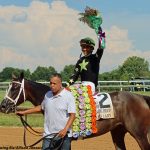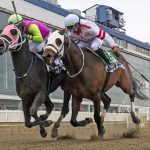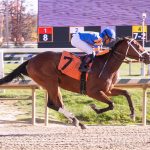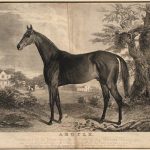At Pimlico, painting the Preakness picture
The Pimlico grandstand has been around a long, long time. So have many of the personnel who have worked within and outside its skeleton, now realizing that not many Preaknesses may be left to be run in it.
On the Thursday before the Preakness, with the media horde buzzing around the grounds, and Sunrise Tours popping up at their designated spots, a variety of workers were readying for the weekend, or finishing a masterpiece, or remembering the past.
- Spa Selections 2025: Saratoga Picks July 11
 Picks and analysis for today’s key races from Saratoga.
Picks and analysis for today’s key races from Saratoga.
Bill Bender and Mike Hess got their jobs through their fathers, who were also gainfully employed at Pimlico. Now working as parking attendants on Preakness weekend, the tenure of the duo spans multiple decades.
Only the job assignment has changed for Bender, of Parkville, who started as an usher, eventually moving on to admissions, program sales and pass exchange agent. The facility itself however has stayed mostly the same.
“This is the exact same building it was in 1973 – nothing has changed,” observed Bender, who has seen some eventful Preakness days. “I saw it when the electrical failed. That was a pretty disastrous day. I’ve seen the pouring down rain just right at the Preakness was run and some years it would rain all day.”
Of course, 1973 was a good year to see your first Preakness.
“I knew it was something special from my father who worked for the racetrack all those years,” noted Bender. “I didn’t realize how big it was.”
What has changed for Bender is the on-track interest of the sport.
“We used to do it 6 days a week,” he recalled. “The Preakness was bigger, of course, than any other day, but we had big days in the seventies that had 20,000 people on a regular Saturday at Pimlico. It wasn’t a real big deal (to see that).”
One of Bender’s frequent visitors included Jim McKay, who came to Pimlico to work and to play.
“Jim McKay was just a regular during the whole season,” Bender remembered. “When he wasn’t working for Wide World of Sports, he was at the track. The Yankees were always here too when they were in town.”
Now mostly retired, Bender said It took him three months after he retired to train himself not to come to the racetrack every morning. Now he only works on the big days.
“The infield was just open. I don’t even remember seeing bathrooms out there,” said Bender of the old times. “If you would have asked me five years ago, I would have said you can’t destroy it. It’s (now) falling apart. The oldest section, we had to close down. That’s probably the only thing left from the ‘40s, maybe the Seabiscuit era. It needs to be fixed.”
Horses were only an emerging interest for Bender before he came to work at the track.
“I really didn’t get to know the horses until I became a horseman’s parking attendant in the stable area. I knew all the people back here. I played softball and grew up with them, but I never saw them working until I got back here.”

Hess knew Secretariat a little bit more than did Bender; his father was a valet for Ron Turcotte.
“I’m a little more sentimental than Bill because I grew up just down the street on Heywood Avenue, less than 100 yards from the entrance,” said Hess, who went to his first Preakness in 1964. “You used to see everybody coming in their business suits, ties and hats walking down Heywood Avenue. When you walk around and see some of the areas around here and you realize that you’re stepping back in time a little bit. It’s ready for it to come down. It’s been a little rough.”
While he is working with Bender this upcoming warm weekend in the parking lot, Hess’s job progression has also varied over the years.
“Everybody that works here has done something different,” noted Hess. “If it wasn’t for the racing, it would just be another shift. The building would just be like a ghost town, and it is getting like that until it gets fixed up.”
Mary McCray, born and raised in Baltimore, began working as a mutuels clerk in the late 1990s and has worked the Preakness event itself for more than 20 times. Thursday morning Mary was preparing gift bags for VIPs, while pulling a little double duty; she is also a mutuel clerk.
Her first Preakness came in 1998, which is also the year the power went out at Old Hilltop when an electrical fire crashed the system on a steamy Saturday. It may have cost the track millions in wagering.
“Fortunately, I was in the infield, but the power went out in the building and everything just went down. Everything came to a slow halt but we were steadily frying in the infield,” recalled McCray, who hasn’t been back to work the Preakness infield since. “The tellers in the infield were working really hard and the tellers in the building had nothing to do.”

“Other duties as assigned” may be a weary caveat for many job holders, but McCray sees it as an asset.
“It’s fun stuff. We love doing this,” she said. “It breaks up the monotony of being on the window all the time. We do a lot of stuff for hospitality. If they need any type of help in other departments, then we just come right here. We’re like family here.”
McCray’s mutuel responsibilities don’t always go smoothly, but she has gained experience in what can at times be a confrontational position.
“It’s all about the customer. It’s like play-by-play how the customer is coming to you,” she said. “If there is an issue, it’s about knowing how to resolve the issue. You get people from different walks but you usually don’t know who they are, but I stay professional.”
Back by the stakes barn, Sam Robinson was working on a piece of art.

“This is the stakes barn Preakness week. It’s a hub. This is the place to be,” said Robinson, applying oil to a canvas for the third time, generating his vision of the stakes. Robinson is a noted equine artist, and while most of his work focuses on the steeplechase world, his brush also brings flat racing to life.
“I’ve painted this view before. I like that deep perspective,” he said of the deep green stakes barn, stretching away from him. “You sort of set this scene up like a stage set and then wait for the actors to come and go, horses, barn staff, security people and people wandering around and it makes a great scene. I can just pick and choose what I want. You have to learn to paint the horse even if they’re not there anymore because they don’t wait and pose for you. When they come by it gives you the idea.”
Robinson is the official artist for the National Steeplechase Association where his equine craft got rooted. Soon, old Pimlico may go, but Robinson is optimistic about the future.
“That’s fantastic and it got the shadow of the bulldozers hanging over us here,” explained Robinson about his new equine interest in his craft he learned a long time ago. “You never know when they are really going to get started (with demolition). I keep telling myself I really should get down to Pimlco more in the immediate future and see what I can do. Everybody’s not sure how long the sport is going to last. I think it has a lot more durability than that. Everybody seems to be mutually interested in doing what they can to keep it all going.”
Robinson takes care in his work but says there’s something to be said of the energy flow between scene and hand.
“The sketches are tough to beat because they have the energy and feel of the scene like nothing else achieves,” he said.
Like many, Robinson is working on getting his strokes in before the old Pimlico fades into memory.
LATEST NEWS














